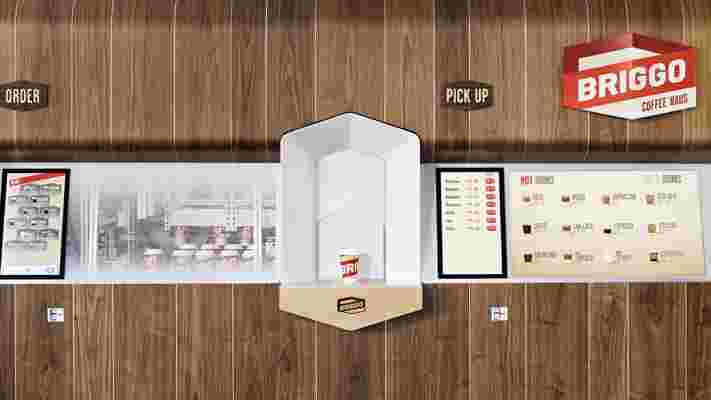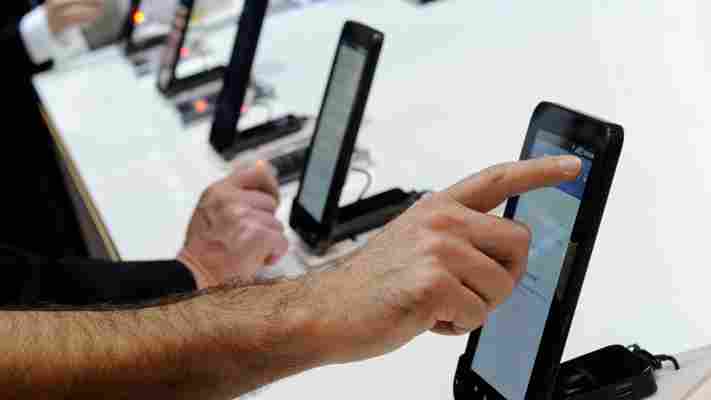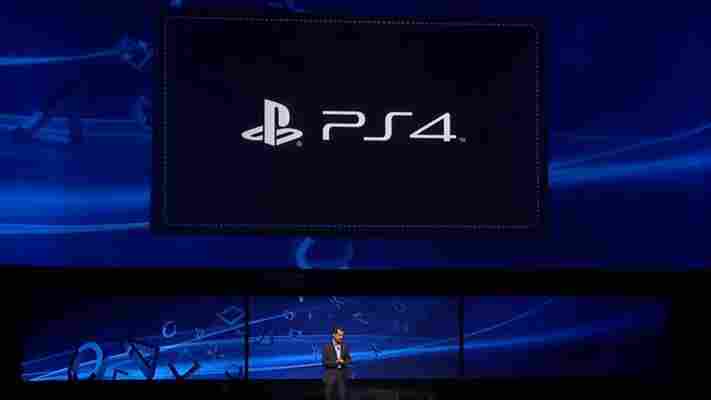Baristas the world over will argue that coffee shops needs a human touch to ensure that customers get a perfect brew day-in, day-out.

Briggo is hoping to change all of that with what it calls the Coffee Haus, a fully automated kiosk that uses robotics to take orders, crush beans and ultimately serve up that little cup of caffeinated goodness.
Customers can submit their order via the company’s mobile site and also select the exact time they would like to pick it up. Briggo then sends the user a text message when it’s ready, eliminating traditional queues and wait times.
But is it good coffee? “The Briggo Coffee Haus individually grinds and brews each espresso beverage and prepares it to order using artisan coffees, fresh milk and gourmet syrups, creating outstanding espresso shots and great lattes,” Scott McMartin, Briggo’s vice president of coffee strategy and operations claims.
The first Briggo Coffee Haus was launched at the University of Texas in Austin earlier this week, replacing a prototype that’s been on campus since 2011. The company now plans to open additional kiosks in airports, hospitals and corporate campuses dotted across the United States.
The kiosk itself was created in partnership with Yves Behar and the rest of the Fuseproject team – the guys behind the design of the OUYA , Fan TV and various Jawbone products.
Although the entire kiosk is automated, the team said it was important to made each Coffee Haus look, smell and feel like a conventional coffee shop. Briggo is also hard at work developing a smartphone app for Android and iOS to streamline saving favorite orders, finding new kiosks and sharing to various social networks.
The question remains though: Can a robot really create a cup of coffee that tastes better than the work of a professional barista? What if I want some chocolate sprinkled on top in the shape of my face?
Image Credit: Briggo & Fuseproject
How the tablet market evolved in 2012: Apple, Google, Samsung, Amazon, and Microsoft go to war
The biggest year for tablets so far was undoubtedly 2012. Amazon and Google stepped up their games, Apple responded accordingly, Samsung flexed its muscles, and even Microsoft showed up to the party. Here’s our take on what happened this year and what it all means.

Before we dive in though, it’s important to acknowledge that there are of course other companies that make and market tablets. The tablet space is still growing very rapidly, but it’s already massive enough for these firms to be able to sell their offerings. Without help from the big guys, however, it is becoming increasingly harder for them to compete. Each of the five has put in a huge amount of resources to ensure they get their cut.
As such, tablet buyers will almost definitely end up supporting the Apple iOS ecosystem, some form of the Android ecosystem (Google’s, Samsung’s, or Amazon’s variations), or Microsoft’s Windows 8 ecosystem. In fact, 2012 showed us that many people will end up with more than just one tablet for themselves, and thus likely multiple in their household.
Without further ado, let’s take a look at the bigger picture of what each company did, and tried to do, this year.
In March, Apple announced the third-generation iPad , only to supersede it in October with the fourth-generation iPad . Yet that announcement was overshadowed by the unveiling of the iPad mini .
This was the second time that Apple had responded to size requirements dictated by the market (the first time being elongating the iPhone 5 after smartphones with larger screens started to flood stores). With the iPad mini, Apple essentially acknowledged that tablets can come in more than one size, unlike its smartphone, as consumers may want something a little smaller and a little lighter.
In doing so, Apple suddenly began offering a less powerful product, with a lower-resolution screen, and at a lower price. While sales numbers aren’t yet available, early indications show the product has been unsurprisingly well received, although there is naturally a question of cannibalization for the larger iPad that has yet to be answered.
Google has been watching its Android partners being pummeled by Apple in tablets and in 2012 decided that enough was enough. In June, the company announced the Nexus 7 . It fared fairly well, but that was just version 1.0.
In October, Google refreshed the device with the release of the Nexus 7 3G as well as the Nexus 10 . Suddenly the company had both small and large tablet offerings, and although Asus is the manufacturer for the former and Samsung for the latter, Google was sending a message that it was very much interested in competing with its partners and other tablet makers.
Again we don’t have proper sales numbers yet, but the Nexus line seems to be gaining a lot of attention. In order to ensure Android becomes the most popular operating system on tablets, as on smartphones, Google realized it had to get in the hardware game.
Samsung has likely been watching Google’s moves warily. The company had the quietest 2012 of all five companies — in terms of tablets — but that doesn’t mean it didn’t sit there twiddling its thumbs.
In February, Samsung announced the Galaxy Tab 2 and the Samsung Galaxy Note 10.1. The latter should not be confused with the six-inch Galaxy Note II phablet.
Samsung tried to keep things simple in 2012 (releasing three tablets instead of five), but it still kept its older models around. Despite this product confusion, the South Korean company still did very well; the latest quarterly numbers gave it second place by tablet shipments.
Those figures show Amazon in third, and it didn’t get there by accident. In 2012, the company continued to use its retail reach to push its devices to the millions who visited its site.
In September, the company announced the successor to its first tablet effort: the Kindle Fire HD , available in 7-inch and 8.9-inch flavors. With its massive online store, Amazon is uniquely positioned to take on its competitors, all of which have deeper pockets.
This year the company showed it’s going to push harder than ever to make sure it has an offering for everyone. Yet as we pointed out , it has become increasingly more apparent this year that the company needs international content if it’s going to keep up with the rest.
Amazon’s Seattle rival may have been in the tablet space for ages, but it only entered “the second coming of tablets” this year. In traditional Microsoft fashion, this was done in the form of a software play, but just as Google did, the company realized it had to jump in its own hardware offering as well.
In June, Microsoft announced the Microsoft Surface , in Windows RT and Windows 8 flavors. It was a big move for the company, and yet it came with a unique spin.
Microsoft showed it isn’t interested in just tablets used for consumption; the company also wants to ensure they can be used for productivity. As such, the Microsoft Surface can be purchased with an attachable keyboard, something that most Windows RT and Windows 8 offerings will likely sport.
The Apple iPad mini starts at $329. The Google Nexus 7 starts at $199. The Amazon Kindle Fire HD 7″ starts at $199. The Samsung Galaxy Tab 2 starts at $249. Microsoft doesn’t have a small tablet offering.
The Apple iPad starts at $499. The Google Nexus 10 starts at $399. The Amazon Kindle Fire HD 8.9″ starts at $299. The Samsung Galaxy Tab 2 10.1 starts at $399. The Microsoft Surface RT starts at $499.
On top of all that, many of the older versions of these tablets are still available at heavy discounts. As we’ve discussed before, there’s a price war going on , and the consumer is the one to benefit in the end.
Most computers today can be purchased for anywhere between $500 and $2,500. To buy a tablet in 2012, you can easily spend less than $1,000, and even less than $500 without having to compromise for an unknown brand.
Furthermore, the depth of tablets significantly slimmed down, while the width and height options continued to increase. Previously, you had to choose between either a 7-inch or a 10-inch, and this likely meant switching brands as well, but 2012 has brought various offerings in between those constraints.
Yet the most important difference among all the tablets in 2012 was the ecosystem. Each of the big five had its own offering and accompanying services, which only continued to expand as the battling powers try to differentiate their screen slabs.
You’ll notice we didn’t mention anything about the patent battle, which had some notable points in 2012. Yet it did not start this year, nor will it be resolved anytime soon. Furthermore, we feel it is a much larger technology issue that has much broader implications.
The patent fight will undoubtedly influence the next year, and the years to come, but it has become more and more clear that will also not stop any of the big five from moving forward in the tablet space. Selling tablets is simply too enticing.
In terms of the tablet market for 2013, it’s difficult to say what will happen for certain, but some basic trends are already apparent. Apple will keep refreshing its tablet offerings, keeping its prices higher than the rest, but ensuring higher quality end-to-end solutions.
Google will focus on its own hardware offerings, as well as accompanying servicers, and will very likely work closer with Motorola. Samsung will continue trying to replicate its smartphone Android strategy in the tablet space, Amazon will keep undercutting everyone and doing its own Android thing, and Microsoft will push forward very hard with its Windows 8/RT strategy.
All of this can’t last. With five lumbering giants throwing their weight around, someone is bound to get hurt. When that happens, it won’t be pretty.
Image credit: Ethan Miller /Getty Images
Sony announces PlayStation 4 with 8-core x86 processor, 8GB GDDR5 memory and DualShock 4 controller
Today at a gaming event in New York City, Sony announced the PlayStation 4. Sony’s Andy House says that it is the ‘most powerful platform ever’.

Of note: Images of the console itself, its pricing or its availability beyond ‘Holiday 2013’ were not announced at this event. That seems almost unconscionably obtuse of the company in this day and age. But that’s the tactic that they’re going with and it’s pretty obvious that there are some details about the product itself and the pricing that have yet to be finalized.
“The living room is no longer the center of the PlayStation universe, the gamer is,” says House. “Every facet of PlayStation will continue to become more powerful…and remains at the heart of everything we create.”
Sony’s Mark Cerny then took the stage to talk about the upgraded console and how the PlayStation ecosystem could be integrated into other platforms like the Vita, as well as smartphones and tablets. He spoke about the way that all of the consoles before have been a ‘single purpose’ device.
“The need to radically customize technology can interfere with the innovation necessary ” to develop a platform like PlayStation, says Cerny. He also spoke about the importance of developers, and how Sony reached out to them to create a ‘platform by game creators, for game creators’. This speaks to the way that Sony altered the architecture of the PS4.
The machine runs on standard PC hardware. An x86 processor similar to those used in many windows machines, a standard (though customized) graphics processor and GDDR5 memory. The 8-core processor and GPU are unified, providing 170GPBS bandwidth.
The PS4 will include a Blu-ray/DVD drive, as well as USB 3.0, Ethernet and Bluetooth.
The new system uses a DualShock 4 controller with a touchpad, share button, lightbar and headphone jack. The lightbar mates with a camera system on the PS4 that allows the console to track the depth (distance away) of the player.
Sony is also updating its PlayStation Eye accessory for the new console. Packed with two cameras and four microphones, it will be capable of 1280 x 800 video at 60fps, 640 x 400 at 120fps and 320 x 192 at 240fps.
There is background uploading and downloading, allowing the console to update game and system items in the background even if the main power is off. Digital titles can even be played while they are being downloaded. This is a huge upgrade over the PS3 which was famous for its lame handling of system updates which set game play back by tens of minutes every time you fired up the console while it updates.
This is enabled by a secondary processor that allows for background work while the main processor is handling gameplay.
The new PlayStation 4 is also highly focused on offering social experiences. You’ll be able to stream your play sessions to allow input, including your friends taking over control to help you out with a rough patch, for instance. You can also quickly share video clips to friends and the PS network.
The PS4 will also support ‘personalization’. The system will learn your likes and dislikes. This means that you will be presented with items that you are more likely to enjoy. Cerny says that the long-term vision is to reduce the download times to zero. If Sony knows what game you’re likely to purchase next, it could, for instance, download it ahead of time.
That promise is pretty wild, actually, and a bit creepy. Though if it works it would be brilliant.
Next up is Gaikai founder Dave Perry, the head of a company Sony purchased last year that allows for heavy compression and streaming of titles.
Gaikai technology will allow you to ‘instantly experience’ any title that you’d like to try. Basically you’ll be able to try out any game demo you like and buy it if you like playing with it. This means that you can choose and play any title online, streaming it nearly instantly before you have to buy it.
Gaikai’s technology is also behind the spectating feature of the PS4 which allows you to share your gaming session with a button push and allows friends to jump in and take over control to help you. Some games will allow people to give you items that will help you in game play like ‘health potions’.
You can also use Remote Play to transfer a PS4 game over to the PlayStation Vita for remote play sessions, similar to the Wii U. Perry says that the long-term goal is to allow any PS4 game to be played on the Vita, though only some titles will work currently.
Perry says that Sony’s long term goal is to allow all PlayStation one, 2, 3 and 4 games to play on any of those devices using Gaikai technology. This would be done by streaming those games onto the platform. This, says Perry, will require the ‘fastest network anywhere’ and that it is being built now. This would theoretically allow you to play any PlayStation game ever on your current console.
Sony then showed a video featuring many game developers talking about the PS4, specifically the amount of time that it takes for players to get involved in games and to boot up their consoles. These developers want people to be able to ‘get into the game’ more quickly. But it was also interesting that they focused so much on these developers, indicating an interesting note of admission that there should be a cleaner, tighter way for them to get their games out to users quickly via the PlayStation.
The Games
Several games were announced at the event, including a title called Knack, which we’ve covered here .
http://www.youtubeom/watch?feature=player_embedded&v=KZKEIQ30cjI
Sony also showed a game by Braid creator Jonathan Blow called The Witness. It looks to be a Myst-like adventure game. During the PS4 launch window, it will only be available on PS4.
And there was also a new Killzone title called Killzone: Shadowfall:
And a new game from Sucker Punch, Infamous: Second Son:
http://www.youtubeom/watch?v=bj5GFc003nI
A game called Driveclub touts challenges over racing:
http://www.youtubeom/watch?v=Bk3B1B-4eI0&list=UUdY8r6XHDUKh4i6ivN0oWIw&index=1
In this announcement, Sony clearly showed that it was targeting the ‘gamers’ out there, rather than Microsoft’s more general push towards capturing household entertainment at large. There were some nods to streaming services like Netflix and more, but the overall presentation seemed oddly focused on the gaming aspects of a ‘living room PC’ when the rest of the industry is branching out from there.
Some notes about the developer focus felt good, as Sony was clearly listening to them on launch times and updates, etc. There may even be some advancements in the way that independent developers generate and submit games, due to the more standard architecture of the PS4 and the heavy focus on digital delivery. Still, no announcements were made about that specifically, so that’s just conjecture.
And that’s about it for the Sony event. Unfortunately, with no picture of the console, pricing or availability beyond ‘holiday 2013’, it’s hard to make any judgements at this point. Stay tuned I suppose.
Update: Added Sony spec sheet and PlayStation Eye info.
